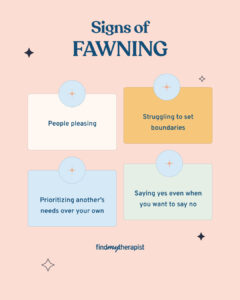The 4 Trauma Responses: Fight, Flight, Freeze, and Fawn

Trauma can shape the way we react to stress, conflict, and relationships. If you’ve ever felt like you respond to stressful situations in a way that feels out of your control, you may be experiencing a trauma response. The four trauma responses – fight, flight, freeze, and fawn – are deeply rooted in survival mechanisms. In this blog, we’ll explore what trauma responses are, how they relate to attachment styles, the signs of each trauma response, and strategies for change and healing.
What is a trauma response?
A trauma response is an automatic reaction to a perceived threat or stressor. When our brain detects danger, it activates the nervous system to protect ourselves. This response originally evolved to help us survive life-threatening or dangerous situations, but for those who have experienced trauma, it can become a default way of handling stressful scenarios.
People who have experienced childhood trauma, abuse, neglect, or intense stress may develop habitual trauma responses that impact their relationships, work, emotional well-being, and mental health. These responses often stem from past experiences where safety and security were compromised, causing the brain to stay in a state of hypervigilance.
The 4 types of trauma responses
Each trauma response serves a different function in protecting us from harm, but when these responses become automatic or maladaptive, they can negatively impact daily life.
1. The fight response
The fight response is characterized by a strong urge to confront the threat head-on. It stems from a survival instinct. When activated, this response may manifest as anger, aggression, a need for dominance, or a need to control the situation. Signs of a fight response include:
- Being quick to anger or defensiveness
- A need for control over situations or people
- Explosive reactions to stress
- Outbursts of anger or irritability
- A need to be “right”
- Physical tension (for example, clenched fists)
Example: Someone who defaults to a fight response might react to criticism at work by immediately arguing with their boss rather than reflecting on the feedback.
For people with unresolved trauma, the fight response may surface in situations where confrontation isn’t necessary. This can lead to difficulties in relationships and overwhelming emotional reactions. Recognizing this pattern can help individuals practice self-regulation techniques like deep breathing or mindfulness to create a sense of safety.
2. The flight response
The flight response is the urge to flee or escape from perceived danger. This could mean physically removing oneself from a stressful situation, emotionally distancing, or mentally checking out through distractions to avoid pain. Signs of a flight response include:
- Avoiding conflict or difficult conversations
- An inability to relax
- Anxiety and restlessness
- Perfectionism
- Overworking
- Feeling overwhelmed
- Avoiding responsibilities
Example: A person with a flight response might end a relationship the moment conflict arises rather than working through and addressing their concerns.
This response can be helpful in dangerous situations, but when it becomes a default reaction to stress, it can lead to anxiety, isolation, and difficulty maintaining close relationships. Therapy can help people recognize when they are in a flight response and develop coping strategies to face challenges instead of trying to escape them.
3. The freeze response
The freeze response occurs when the nervous system shuts down in the face of a threat or stress. It’s a survival mechanism where a person becomes still, making them less detectable to danger. They may shut down emotionally, physically, or mentally. Signs of a freeze response include:
- Feeling numb
- Feeling dissociated or zoning out
- Struggling to make decisions
- Feeling disconnected or numb
- Procrastination
- Struggling with time management
Example: A student experiencing a freeze response may find themselves unable to start an important project, even though they know it needs to be completed.
People who frequently experience the freeze response may struggle with motivation and feeling disconnected from their surroundings or emotions. Grounding exercises, movement-based therapy, and trauma-informed counseling can help individuals reconnect with themselves and move forward.
4. The fawn response
 The fawn response is a survival mechanism that involves pleasing others to avoid conflict or gain approval. This response often develops in people who have experienced trauma or emotional neglect. Signs of a fawn response include:
The fawn response is a survival mechanism that involves pleasing others to avoid conflict or gain approval. This response often develops in people who have experienced trauma or emotional neglect. Signs of a fawn response include:
- Difficulty setting boundaries
- Fear of saying no
- People-pleasing behavior
- Prioritizing others’ needs over their own
- Fear of conflict
- Suppressing personal emotions or opinions
Example: A person with a fawn response might agree to take on extra work, even when feeling overwhelmed, just to avoid disappointing their boss.
People who default to fawning may struggle with self-identity and self-worth, as their needs often take a backseat to others. Learning to set boundaries, recognizing personal needs, and building self-confidence can be crucial in overcoming the fawn response.
Trauma responses and attachment styles
Trauma responses are closely linked to attachment styles, which develop in early childhood. This can be based on caregivers responses to a child’s needs. These attachment styles can influence which trauma response becomes dominant.
- Secure attachment: Individuals with secure attachment styles are less likely to develop extreme trauma responses because they likely had consistent emotional support growing up.
- Avoidant attachment: Those with avoidant attachment may lean toward flight responses, withdrawing from emotional intimacy and conflict.
- Anxious attachment: Those with anxious attachment may lean towards fight or fawn responses, feeling the need to either assert control or please others to maintain relationships.
- Disorganized attachment: Those with disorganized attachment may cycle between fight, flight, freeze, and fawn, often feeling confused and overwhelmed by relationships.
Understanding your attachment style can help you to recognize patterns in your trauma responses and work towards healthier coping mechanisms.
How to change your trauma response
Recognizing your dominant trauma response is the first step toward change. Here are some ways to begin shifting toward healthier responses:
- Practice self-awareness: Identify your dominant or default trauma response in stressful situations. Journaling or talking with a therapist can help you to recognize patterns.
- Challenge negative thought patterns: Trauma responses are often fueled by deep-rooted fears or beliefs. Work on reframing thoughts such as “I must always be in control” or “I am not worthy of setting boundaries.“
- Try new coping strategies: If you tend to respond with the fight trauma response, practice pausing before reacting. If you respond with the flight trauma response, try staying present in discomfort rather than avoiding it.
- Practice mindfulness and grounding: Techniques like deep breathing, meditation, and grounding exercises can help regulate your nervous system and prevent automatic trauma responses.
How to cope with trauma
Healing from trauma takes time, patience, and self-compassion. Here are some ways to support your healing journey.
- Try therapy: Therapy modalities like EMDR, cognitive-behavioral therapy (CBT), and somatic therapy can be helpful.
- Practice healthy boundaries: Learning to say no and advocate for your needs can reduce stress and prevent triggering trauma responses.
- Practice self-care: Engage in activities that you find relaxing, such as exercise, journaling, creative outlets, or spending time in nature.
- Lean on your support system: Connecting with friends, family, or local support groups can provide reassurance and validation.
- Educate yourself: Learning about trauma and nervous system regulation can empower you to take control of your healing journey.
Takeaway
Understanding your trauma response can be an important step in healing. Therapy can provide a safe space to explore these responses, process past trauma, and develop healthier coping mechanisms. Whether it’s through cognitive-behavioral therapy, mindfulness, or somatic therapies – healing is possible.
If you recognize yourself in any of these trauma responses and want mental health support, visit findmytherapist.com. At findmytherapist.com, you can choose your therapist and schedule your first appointment directly online.
Ready to prioritize your mental health?
Great Lakes Psychology Group is here to help. With an extensive network of caring therapists available to meet online or in-person, we make it easy to find the right fit for your unique needs.



